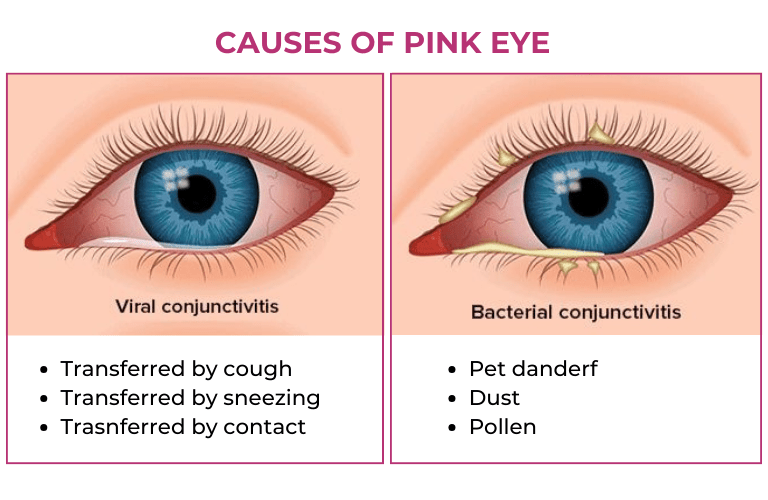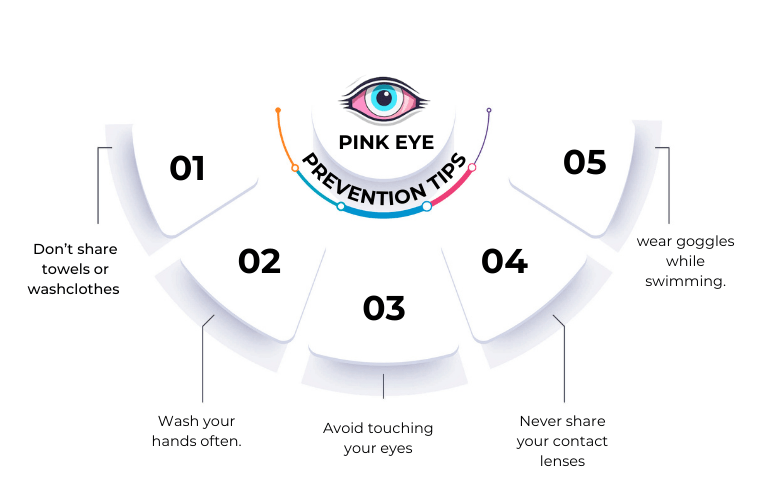
Is Pink Eye Contagious?
The redness of the white part of the eye due to viral or bacterial infection is called pink eye or conjunctivitis. It is a contagious disease. Though the redness can also be due to allergens or foreign materials they are not contagious.
The most common type of conjunctivitis is caused by virus ( enterovirus 70, coxsackievirus A24, and adenoviruses) and bacteria (Staphylococcus species) and the pink eye is highly contiguous and can be transmitted even after the 10 days of initial symptoms.
How Pink Eyes Spread?

The infection of conjunctiva spreads just like a normal viral or bacterial infection through air or contact. The incubation period of both virus and bacteria causing pink eye lies between 24 to 72 hours. However, the bacteria and virus remain alive for up to 8 hrs. on the surface. Once you touch your eyes with these infected hands you can easily catch the pink eyes.
Some of the common ways in which pink eyes can be transmitted are:
- Direct Contact:
Direct contact with an infected person or surface can result in a pink eye infection. Once you contact an infected person you should wash your hands with soap and change clothes to avoid infection.
- Indirect contamination:
Pathogens that cause pink eye can persist on surfaces such as doorknobs, counters, or shared goods such as towels and pillowcases and live from a few hours to a few days. If you come in contact with such a surface and touch your eyes with these hands you can easily catch the infection.
- Airborne Transmission:
Viral infections, particularly adenoviruses, are one of the most common causes of pink eye. These viruses spread via respiratory droplets or direct contact with contaminated surfaces, causing redness, watery discharge, and eye irritation. Viral conjunctivitis is extremely contagious and can cause cold-like symptoms.
- Contact with discharge:
Pink eye frequently causes discharge from the eyes, which includes infectious organisms. Transmission can occur by direct touch with this discharge, such as exchanging personal objects such as towels.
- Self-Inoculation:
Viral infections, particularly adenoviruses, are one of the most common causes of pink eye. These viruses spread via respiratory droplets or direct contact with contaminated surfaces, causing redness, watery discharge, and eye irritation. Viral conjunctivitis is extremely contagious and can cause cold-like symptoms.
- Vertical Transmission:
Rubbing or touching one eye and then touching the other eye might cause the infection to spread from one eye to the other.
- Unwashed Hands:
Practicing poor hygiene can also spread the pink eye infection. The contaminated hands when touching the eyes and near areas of the face can initiate infection in the eyes.
How to Detect Pink Eyes
The following symptoms will help you to understand you have developed pink infections:
Redness of the white part of your eye or inner eyelid.
Watery eyes or continuous tearing.
A thick yellow discharge appears especially after sleeping.
Persistent Intching.
Burning sensation.
Blurred vision.
Increased sensitivity to light.
Swollen eyelids.
If you find any of the following symptoms you should look for the right treatment after consultation with the eye specialist. MM Joshi Eye Institute has a team of eye specialists who are experts in all types of eye problems and will guide you with the best treatment suitable for your eyes.
Preventive Measures to Stop the Spread of Pink Eyes

Each year, countless individuals contract pink eye, but by following hygiene and precautionary measures, we can substantially decrease the number of pink eye infections.
Wash your hands properly with soap and water to avoid any kind of infection especially when you come in contact with an infected person.
Avoid rubbing the eyes with your hands, it can increase the chances of infection.
Do not share your items such as towels, bedding, eyeglasses, and contact lenses with anyone to combat infection.
Disinfect frequently touched surfaces such as door knobs, countertops, etc. to reduce the spread of infection.
Limit the use of your contact lens, and eye makeup till the infection lasts.
Do not go to the workplace or school till you recover from the pink eyes.
Use disposable tissues and napkins and dispose of them with utmost care to avoid any spread of these contaminated used tissues.
Treatment of Pink Eye
Early Detection
Early identification of pink eye is very important as once detected a proper treatment can be given and its spread can be minimized. Check for the above-mentioned symptoms and connect to your doctor once you feel you are having a pink eye infection.
Treatment
The treatment of pink eye depends on the type of infection incurred.
Viral infection does not require any medicine; it will go away on its own in 3 to 5 days. However, in some cases, it may take up to 10 days for a full recovery. However, bacterial infection requires some antibiotics prescribed by the doctor in addition to proper hygiene practice. However other infections caused by allergens and foreign material can be treated by using anti-allergens or cutting out the reach of that allergens in the eyes.
One should note that bacterial and viral pink eye is highly contagious so it is advisable to follow the prescribed medicine and precautions to combat its spread.
Home remedies such as using a cool compressor, taking rest, cleaning with a damp cloth, etc. can reduce eye pain and help you get relief to a certain extent
Conclusion
Pink eyes caused by viruses and bacteria are contagious and require proper treatment and care to recover. They do not have any impact on the vision of your eyes. But treating Pink eyes in time will help you to recover early.
FAQs
-
Is pink eye contagious and how does it spread?
Yes, pink eye (conjunctivitis) is contagious. It spreads through direct contact with an infected person, or by touching surfaces or objects contaminated with the virus or bacteria causing pink eye, then touching the eyes with infected hands.
-
Can you spread pink eye by being around someone?
Yes, you can get a pink eye infection if you touch the contaminated items and then touch your hands and face with these contaminated hands. The virus can also spread through contaminated surfaces so use a disinfectant while taking care of an infected person.
-
Can pink eye spread by kissing?
The infection of pink eye spreads through direct contact between the persons. The chances of spread increase when you hug, kiss, or even handshake with an infected person. Make sure you do not come in physical contact with the infected person to combat the spread.
-
Should I avoid people with pink eye?
No, you should take care of an infected person but with some precautions. Disinfect your hand regularly and avoid touching of eyes and face as much as possible.
-
What kills pink eye on surfaces?
The use of a disinfectant that has been approved by the EPA, such as a bleach-based solution (2,000–5,000 ppm chlorine or 10–25 teaspoons of bleach per gallon of water) can kill the virus-spreading pink eyes. Make sure the cleaning agents are left on all surfaces for the advised contact duration. Apply wet, then let dry.


